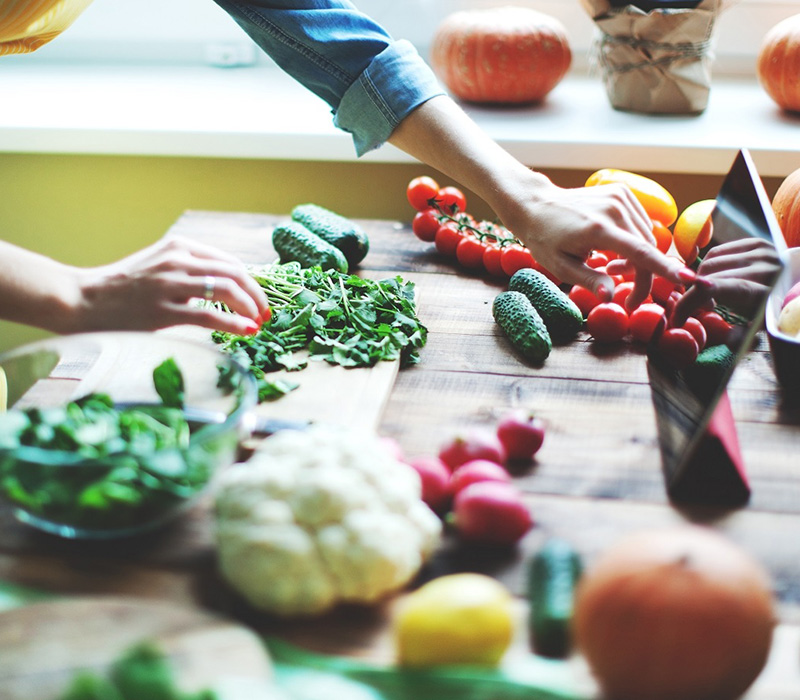-
Using our recipes
Here are some of our tips for success with ATCO Blue Flame Kitchen recipes.
-
-
Before You Begin
- Read each recipe through before starting to cook.
- Gather all the ingredients and prepare them as directed in the ingredient list before starting the method.
- Prepare pans and preheat the oven before beginning to cook.
-
Measuring
- Measure liquids in glass or clear plastic liquid measuring cups.
- Measure dry ingredients in nesting dry measuring cups (usually made of metal or plastic) that can be levelled off with a straightedge, such as a knife.
- Measure flour by spooning (not scooping) it into a dry measuring cup. Level off with a straightedge without tapping or shaking the cup.
- Do not sift flour unless otherwise specified.
- Measure brown sugar by packing it firmly enough into a dry measuring cup so that it holds the shape of the cup when turned out.
- Unless otherwise specified, do not sift icing sugar before measuring.
- Unless otherwise specified, unsweetened cocoa powder is first measured and then sifted.
-
Ingredients
- For best results, use good-quality ingredients.
- Use all-purpose flour unless otherwise specified. If other flour (unbleached, whole wheat, etc.) is substituted, there may be a change in texture.
- Use butter when called for in recipes. Do not use soft tub margarine or vegetable oil as a substitute as this may adversely affect the final product.
- Use golden brown sugar where specified and dark brown sugar where specified. If a recipe simply calls for packed brown sugar, use either type.
- Unless otherwise specified, do not use light (lite) or low-fat products (cream cheese, mayonnaise, sour cream, peanut butter, etc.) as they may give poor results due to differences in fat and moisture content.
- Unless otherwise specified, low fat and regular sweetened condensed milk may be used interchangeably.
- Use chocolate chips made from pure chocolate. All chocolate chips are formulated to keep their shape in baking and may not melt smoothly. Imitation chocolate-flavoured chips may be very difficult to melt.
- All fruits and vegetables should be thoroughly washed before using.
- Carrots, onions, parsnips, garlic and fresh ginger should be peeled before using.
Unless otherwise specified, assume that:
- Flour is all-purpose.
- Sugar is granulated (white).
- Honey is liquid, not creamed.
- Molasses is fancy molasses.
- Peanut butter is smooth.
- Butter is salted.
- Eggs are large.
- Milk is 2% M.F. (milk fat) and light cream is 10% M.F. (milk fat)
- Yogurt is plain (unflavoured).
- Salt is table salt and pepper is freshly ground pepper.
- Oil is canola, olive oil is extra virgin and sesame oil is light brown in colour.
- Vanilla is pure vanilla extract.
-
Techniques
- Butter, margarine and cream cheese are allowed to soften at room temperature for easier creaming.
- Egg whites will give a greater volume if allowed to stand at room temperature for 30 minutes before beating.
- Whipping cream will whip faster if both bowl and beaters are chilled in the freezer for 15 minutes before whipping. Generally, the cream is whipped to soft peaks when it is to be folded into a dessert base. When it is whipped enough to hold its shape, or stiff, it is perfect for use as a dessert garnish.
- When melting chocolate, melt slowly in a heavy saucepan over very low heat or on top of a double boiler over hot, not simmering, water. Moisture or overheating chocolate will cause it to "seize" or become thick. Remove chocolate from heat before all chocolate is melted. Stir to melt the remaining chocolate.
- Follow the doneness tests described in the recipes. Cooking times should be used only as a guideline.
-
Equipment
- A baking pan refers to a metal pan, while a baking dish refers to a glass or ceramic dish.
- When measuring the dimensions of baking pans and baking dishes, measure the distance, across the top from the inside rim on one side to the inside rim on the opposite side.
- Frying pans may be described in size as small, medium or large. Usually, small frying pans are 5 - 8 inches (12.5 - 20 cm) in diameter; medium frying pans are 9 - 10 inches (23 - 25 cm) in diameter; and large frying pans are about 12 inches (30 cm) in diameter.
- A Dutch oven is a large saucepan/pot with a tight-fitting lid. It is wider than it is tall and usually has two heatproof handles instead of one so that it can be easily transferred to and from an oven.
-
Before You Begin
